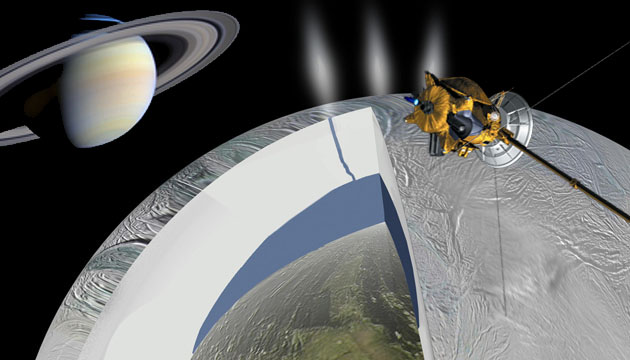
Over 500 years since Vasco Nunez de Balboa “discovered” the Pacific Ocean (never mind that the Chinese, Japanese, and Pacific Islanders already lived along or within it), modern explorers have found yet another previously unknown ocean–on Saturn’s moon Enceladus.
The discovery was made by NASA’s Cassini spacecraft over the course of 19 flybys of Enceladus. And while Cassini is not equipped with instrumentation designed to look within an object and see what’s there, NASA was able to take advantage of Cassini’s communications gear to infer the ocean’s presence.
The concept is straightforward, even if it may seem like using a divining rod to find water. As the Cassini spacecraft flew by Enceladus, beaming a radio communications signal back at Earth as it went, its trajectory was altered slightly by gravitational “bumps,” or “potholes,” in its path. The “potholes” are variations in the strength of Enceladus’ gravity caused by differences in mass density on and under its surface.
Cruising through areas of weaker and stronger gravity as it passed over regions of lesser and greater density, Cassini’s flight path dithered up and down like an airplane flying through pockets of air turbulence.
By measuring minute shifts in the frequency of Cassini’s radio transmissions caused by the Doppler effect (the same phenomenon that enables a highway patrol officer with a radar gun to catch you speeding), the variations in speed toward and away from Earth were calculated. Velocity variations as low as 1 foot per hour can be measured in this way. (If the highway patrol’s radar guns were of NASA caliber, they’d be able to tell the difference between 55 and 55.0002 mph. Just saying.)